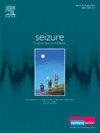Severe epilepsy phenotypes in adults with succinic semialdehyde dehydrogenase deficiency: Novel clinical and therapeutic insights from an Italian multicenter retrospective cohort study
IF 2.8
3区 医学
Q2 CLINICAL NEUROLOGY
引用次数: 0
Abstract
Purpose: To describe the epileptic phenotypes in a series of adults with succinic semialdehyde dehydrogenase deficiency (SSADHD) and to evaluate the efficacy of novel treatments.
Methods: We retrospectively reviewed the charts from seven adult patients followed at four Italian Epilepsy Centers. All cases had biallelic variants in the ALDH5A1 gene; three of these were novel: c.1205T>A (p.Val402Glu), c.1630delT (p.Cys544Valfs*15), and c.141C>G (p.Tyr47Ter).
Results: Patients (age at last follow-up: 33.8 ± 8.8 years) had moderate motor deficits and variable degrees of intellectual disability, often with psychiatric symptoms. Epilepsy had heterogeneous presentations, with a mean onset age of 13.1 ± 7.7 years. Drug-resistant seizures and convulsive status epilepticus (SE) occurred in five and three patients respectively; two had possible sudden unexpected death in epilepsy. Prolonged episodes of impaired awareness that preceded or followed convulsive SE were associated with epileptic discharges on EEG and were classified as non-convulsive seizures. In two patients, add-on cenobamate led to a reduction in tonic-clonic seizures and SE. In all cases, brain MRI showed T2 hyperintensity in pallidi and dentate nuclei.
Conclusions: Epilepsy in SSADHD is believed to result from compensatory mechanisms within the GABAergic system. Cenobamate could have a therapeutic effect on patients with SSADHD by modulating GABAA receptors via a non-benzodiazepine site. However, this observation warrants further investigation, including potential benefits beyond seizure control. Epileptologists should consider SSADHD in patients with prolonged non-convulsive seizures or SE, especially when accompanied by developmental, movement, or psychiatric comorbidities and the characteristic neuroradiological features.
琥珀半醛脱氢酶缺乏症成人的严重癫痫表型:来自意大利多中心回顾性队列研究的新临床和治疗见解
目的:描述一系列成人琥珀半醛脱氢酶缺乏症(SSADHD)的癫痫表型,并评价新治疗方法的疗效。方法:我们回顾性地回顾了在意大利4个癫痫中心随访的7名成年患者的病历。所有病例均存在ALDH5A1基因双等位变异;其中三个是新的:c.1205T>A (p.Val402Glu), c.1630delT (p.Cys544Valfs*15)和c.141C>G (p.Tyr47Ter)。结果:患者(末次随访年龄:33.8±8.8岁)有中度运动障碍和不同程度的智力障碍,常伴有精神症状。癫痫的表现具有异质性,平均发病年龄为13.1±7.7岁。耐药癫痫发作5例,癫痫持续状态(SE) 3例;其中两人可能因癫痫猝死。惊厥性SE之前或之后意识受损的长时间发作与脑电图上的癫痫放电有关,并被归类为非惊厥性发作。在两例患者中,加用辛奥巴酸导致强直阵挛性发作和SE的减少。所有病例的脑MRI均显示苍白体核和齿状核T2高信号。结论:SSADHD患者的癫痫被认为是gaba能系统内的代偿机制所致。Cenobamate可能通过非苯二氮卓类药物位点调节GABAA受体对SSADHD患者有治疗作用。然而,这一观察结果值得进一步调查,包括癫痫发作控制以外的潜在益处。癫痫学家应考虑长期非惊厥性发作或SE患者的SSADHD,特别是当伴有发育、运动或精神合并症和特征性神经放射学特征时。
本文章由计算机程序翻译,如有差异,请以英文原文为准。
求助全文
约1分钟内获得全文
求助全文
来源期刊

Seizure-European Journal of Epilepsy
医学-临床神经学
CiteScore
5.60
自引率
6.70%
发文量
231
审稿时长
34 days
期刊介绍:
Seizure - European Journal of Epilepsy is an international journal owned by Epilepsy Action (the largest member led epilepsy organisation in the UK). It provides a forum for papers on all topics related to epilepsy and seizure disorders.
 求助内容:
求助内容: 应助结果提醒方式:
应助结果提醒方式:


